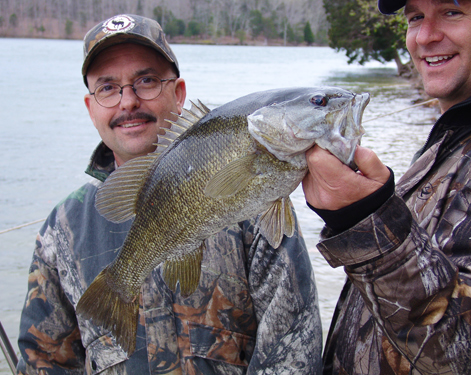BY Lee McClellan
FRANKFORT, Ky. – You hear about Lake St. Clair, Mille Lacs, Lake Erie and the upper Mississippi River as waters that produce the best smallmouth fishing in the United States.
As far as catching numbers of smallmouth with many of those larger than 4 pounds, you can’t argue with the sentiment. However, to catch the largest specimens in the world, you need to fish in Kentucky and Tennessee.
This statement isn’t regional boastful pride or being a homer, it is fact. The three largest smallmouth bass on the ESPN/Bassmaster Top 25 Smallmouth Bass list came from one water body: Dale Hollow Lake, which straddles the Kentucky-Tennessee line in south-central Kentucky.

The all-tackle world record came out of Dale Hollow, an 11-pound, 15-ounce behemoth. Leitchfield’s David L. Hayes caught that fish by trolling points in the Kentucky section of the lake on the morning of July 9, 1955. Dale Hollow produced John Gorman’s second place smallmouth, a 10-pound, 14-ounce fish caught in April 1969. Gorman fooled the smallmouth with a white doll fly fished in the Obey River arm of the lake. Paul Beal’s 10-pound, 8-ounce third place smallmouth struck a smoke-colored grub in April 1986 from the Hendrick’s Creek arm of the lake.
In all, six of the top 10 smallmouth bass on the list came from Dale Hollow.
“The upper Cumberland River system has great smallmouth bass genetics,” said John Williams, southeastern fisheries district biologist for the Kentucky Department of Fish and Wildlife Resources. “Since this general area produces the biggest smallmouths on record, the genetics are excellent for producing huge specimens.”
Kentucky is blessed with three world-class smallmouth lakes: Laurel River Lake, Lake Cumberland and the upper section of Dale Hollow Lake that produced the world record. Williams and his crew oversee the smallmouth bass management on Laurel River Lake and Lake Cumberland and assist with the Kentucky portion of Dale Hollow Lake.
The numbing cold of this past winter has fishing rhythms well behind most years. March is normally one of the best months of the year for trophies, but this year it will be April as water temperatures are just now breaking into the upper 40s on these lakes.
In spring, smallmouth bass move from their winter hideouts – along steep points, bluffs or suspended above channel drops – toward their spawning grounds on gently sloping banks that run from shallow to medium-depth water.
Long, extended points that run well out in the lake also make good spring areas in these lakes as do the shallow ends of small coves that run off the main lake or a major creek arm.
Jerkbaits and swimbaits also fool smallmouths on sloping banks in spring. Anglers report catching smallmouth bass above 4 pounds recently on Dale Hollow using Tennessee shad-colored swimbaits and clown-colored jerkbaits fished on gently-sloping pea gravel banks. Those banks with some grass on them are best.
“If wanted to catch a smallmouth bass 6 pounds or better, I would go to Laurel River Lake,” Williams said. “I hear regularly of smallmouths over 7 pounds coming from the lake and it seems to improve every year.”
Small, pearl-colored swimbaits rigged on ¼-ounce lead-head jigs are deadly in spring on long, sloping points in Laurel. Blade baits ripped off the bottom and allowed to settle again also work well in these spots. Watch your line intently when the blade bait sinks to bottom again as smallmouth often pick it off as it settles.
“Laurel is harder to fish and can be terribly frustrating and you’ll leave convinced there isn’t a smallmouth in it,” explained Williams, who caught his personal best 6-pound, 3-ounce smallmouth from the lake two years ago. “Then, you catch a monster and you are motivated again.”
The smallmouth population in Lake Cumberland is consistently good year after year. “The lake’s smallmouths are in great condition with many 20-inch and longer fish in the population,” Williams said.
The sloping banks near Low Gap Island, in the middle and lower sections of Otter, Caney and Wolf creeks all have excellent trophy spring smallmouth potential. Swimming a small black and purple or olive hair jig just above bottom in these areas produces strikes right now. Slowly working deep-diving red or orange and brown crankbaits from shallow to deep on these banks works well.
Crawling or swimming 5/16-ounce finesse jigs in the Cumberland Craw color along the bottom in these areas also draws strikes as does deadsticking black finesse worms on ¼-ounce Shakey heads.
The rip-rap along the dam almost always holds spring smallmouths.
“These lakes have the potential to produce world-class specimens in springtime,” Williams said. “Now is the time to fish if you can.”
Author Lee McClellan is a nationally award-winning associate editor for Kentucky Afield magazine, the official publication of the Kentucky Department of Fish and Wildlife Resources. He is a life-long hunter and angler, with a passion for smallmouth bass fishing. Get the latest from Lee and the entire Kentucky Afield staff by following them on Twitter: @kyafield.
-30-
The Kentucky Department of Fish and Wildlife Resources manages, regulates, enforces and promotes responsible use of all fish and wildlife species, their habitats, public wildlife areas and waterways for the benefit of those resources and for public enjoyment. Kentucky Fish and Wildlife is an agency of the Tourism, Arts and Heritage Cabinet. For more information on the department, visit our website at fw.ky.gov.


Be the first to comment